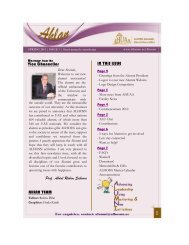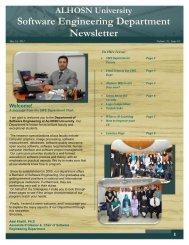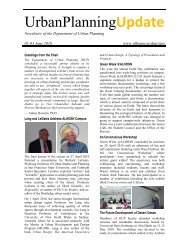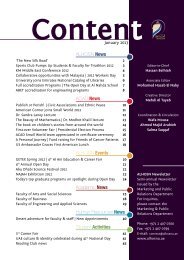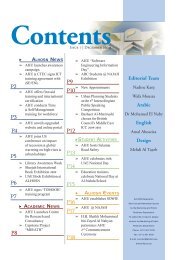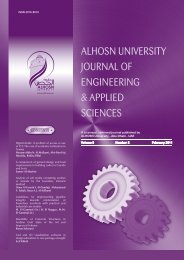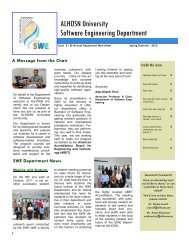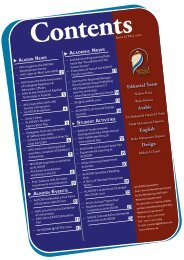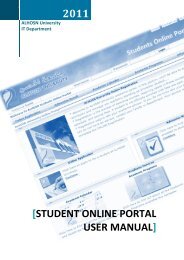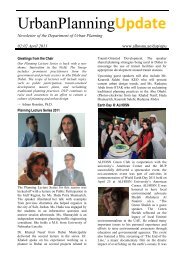ALHOSN University Catalogue Global Knowledge with Local Vision ...
ALHOSN University Catalogue Global Knowledge with Local Vision ...
ALHOSN University Catalogue Global Knowledge with Local Vision ...
You also want an ePaper? Increase the reach of your titles
YUMPU automatically turns print PDFs into web optimized ePapers that Google loves.
CIV 313 Structural Systems II (3 = 3 + 0) (Spring)<br />
Prerequisite: CIV 303<br />
This course continues <strong>with</strong> the further development and refinement of structural systems as they relate to loading. It<br />
aims at providing students <strong>with</strong> the techniques required to analyze statically indeterminate structures such as<br />
trusses, beams and frames using several common methods such as the force method, slope deflection method and<br />
the moment distribution method. The basics of the design philosophy are also introduced in this course.<br />
CIV 314 Computations and Systems Modeling (3 = 3 + 0) (Spring)<br />
Prerequisite: CIV 303<br />
This class introduces the application of various computational methods for solving a range of practical problems in<br />
civil engineering. Basic numerical methods for solving algebraic equations, non-linear and eigenvalue<br />
problems, as well as numerical differentiation and integration introduced. Curve- fitting and non-linear<br />
regression techniques are presented. Computational tools are introduced and used to analyze structural systems<br />
and other topics of interest in infrastructure systems.<br />
CIV 315 Construction Planning (3 = 3 + 0) (Spring)<br />
Prerequisite: CIV 305<br />
This class deals <strong>with</strong> construction administration, bidding procedures, contracting methods, planning and<br />
execution of civil engineering construction projects. The class also covers planning and scheduling techniques<br />
such as CPM. The class presents basic methods of estimating construction costs, <strong>with</strong> applications to<br />
construction projects.<br />
CIV 316 Heavy Construction Materials (3 = 3 + 0) (Spring)<br />
Prerequisite: CIV 305<br />
This course deals <strong>with</strong> the functions and planning of heavy construction materials. Equipment used in earth<br />
moving, bridge building, and heavy lifting, as applied in construction of buildings, bridges, high rise, and other<br />
applications will be studied in details. <strong>Local</strong> construction sites will be visited as part of the laboratory sessions. The<br />
field trips will form the basis of design and simulation work involved in heavy construction materials.<br />
Optimization of such resources will also be presented.<br />
CIV 401 Geotechnical Engineering (3 = 2 + 1) (Spring)<br />
Prerequisite: CIV 301<br />
This class is concerned <strong>with</strong> the geotechnical aspects of temporary and permanent retaining walls for<br />
infrastructure or environmental works, deep and shallow foundations and design/analysis of natural cuts and<br />
embankments. The application of these design/analyses to particular infrastructure and environmental structures<br />
are emphasized in the laboratory sessions.<br />
CIV 402 Design of Steel Structures (3 = 3 + 0) (Fall)<br />
Prerequisite: CIV 303 and CIV 313<br />
This introductory design class emphasizes the behavior and design of steel members resisting tensile,<br />
compressive, and flexural loads and simple connections of these elements. Members subject to combined loading<br />
will also be studied. Upon class completion, the student will be able to design steel structural elements according<br />
to current design code provisions though most design examples will be based on framed buildings. Many of the<br />
concepts apply equally to other types of structures; e.g. bridges, towers, and submarine hulls.<br />
CIV 411 Reinforced Concrete Design (3 = 3 + 0) (Fall)<br />
Prerequisite: CIV 313<br />
This class will provide students <strong>with</strong> a basic understanding of the behavior and analysis of reinforced concrete as<br />
a structural material and utilize them <strong>with</strong> elementary skills and concepts necessary for designing a variety of<br />
common structural elements. Current design code provisions related to flexure, shear and compression members<br />
will be reviewed leading to practical design examples for beams, columns and slabs. Appropriate analysis<br />
techniques and code approximations will be presented through the use of relative software.<br />
CIV 419 Energy, Environment and Communication (3 = 3 + 0) (Fall)<br />
Prerequisite: CIV 315<br />
This course introduces the history of engineering and develops understanding of the role of industrialization in<br />
the modern age in shaping the lifestyle of the society. Various traits of the information age are identified and the<br />
principal features of technology development are discussed in this course. The flaws and strengths of the currently<br />
practiced engineering approaches are highlighted in order to develop understanding of the role of an engineer in the<br />
society.<br />
CIV497 Senior Design 1 (3 = 0 + 3) (Fall)<br />
99



